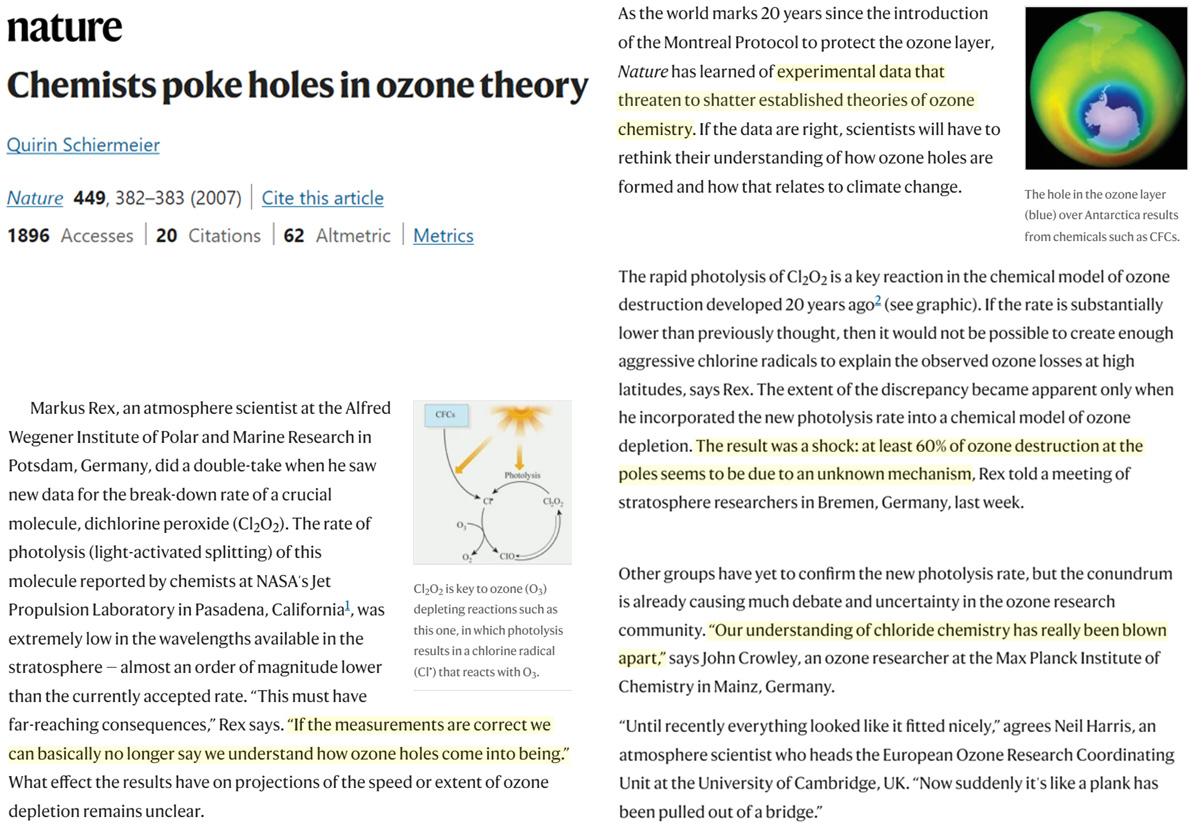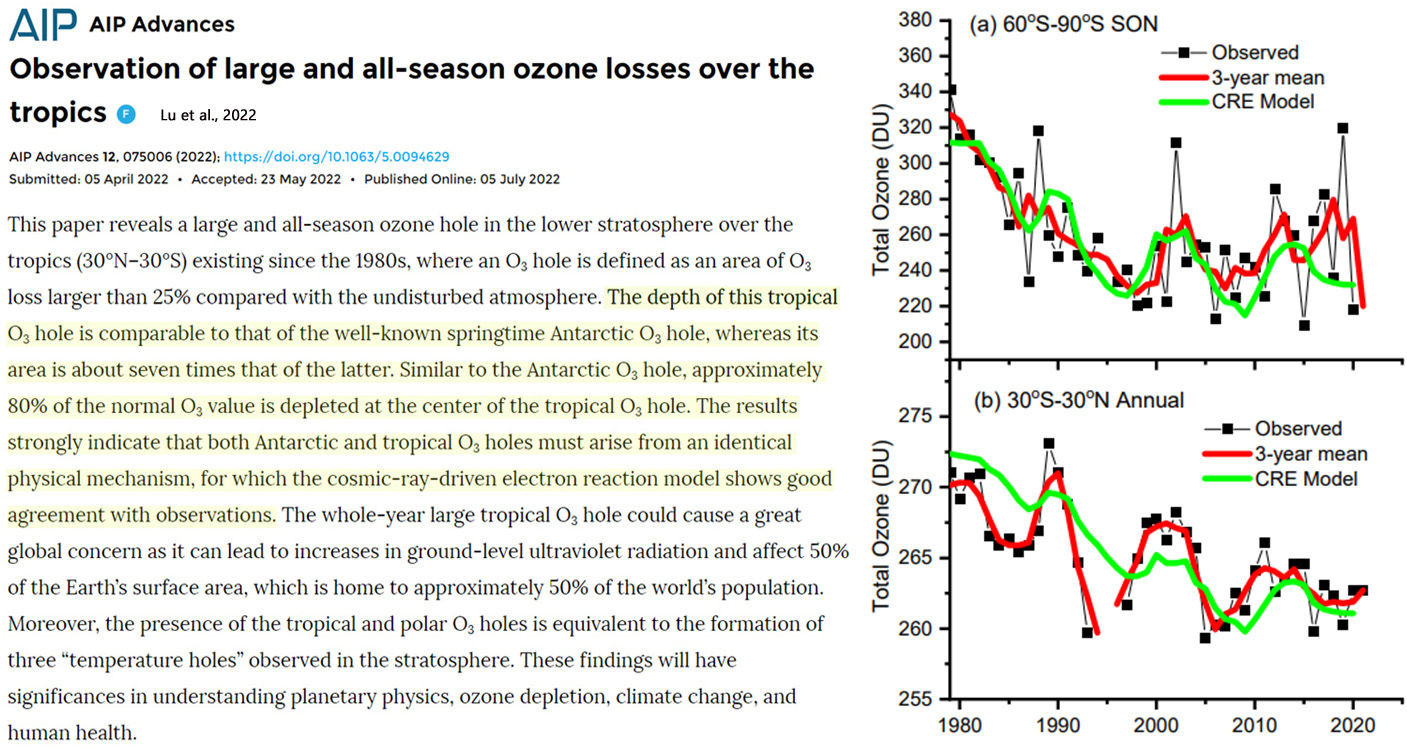The increasing loss of ozone (O3) from 3o°N – 30°S has steadily accelerated since the early 1980s despite the 1987 Montreal Protocol’s ban on so-called “ozone depleting substances” like chlorofluorocarbons (CFCs). Once again this suggests human activity does not drive ozone losses.
Twenty years after the Montreal Protocol agreement limiting or banning CFC use scientists reported an order-of-magnitude-sized error in molecular chemistry measurements that threatened to severely undermine the commonly accepted anthropogenic explanation for how ozone depletion occurs.
With the new measured evidence, a leading ozone researcher proclaimed the scientific “understanding of chloride chemistry has really been blown apart,” as “we can basically no longer say we understand how ozone holes come into being.”

Image Source: Schiermeier, 2007
But then, in the ensuing years after the measurement error had been exposed, there was . . . silence. The discovery of a molecular rate change “substantially [ten times] lower than previously thought” was not brought to the public’s attention again. Ostensibly due to a reluctance to admit they may be wrong, scientists just seemed to . . . move on.
Now, a new study reports the O3 hole over the tropics is 700% larger (area) than the much more famous O3 hole over Antarctica (60°S – 90°S).
Its size has continued widening after the 1987 governmental agreement to severely limit CFC use, which again seems to contradict claims that we humans can control O3 levels with our emissions.
The authors suggest the same non-anthropogenic physical mechanism – cosmic ray-elicited electron reaction – driving O3 losses over Antarctica may also be driving the O3 losses for 3o°N – 30°S.

Image Source: Lu et al., 2022
The ozone hole narrative and the presumption that governmental policies are what determine how small or large the hole gets would appear to be analogous to the current climate debate and its connection to the governmental push to dramatically limit CO2 emissions.





Good post. Thanks.
For the record: I quit worrying about the Ozone Hole about 10 years ago — about the same time I quit worrying about climate armageddon.
Quitting from worrying about governement or governement financed predictions is a wise move. So far NONE of the predicted catastrophes have materialised so far.
https://www.youtube.com/watch?v=qHINqJJS20k
Ozone depletion.
It might be called The Rachel Carson snare or the volcano-god syndrome.
So does this mean the ozone theory of global warming is back in vogue. Or will it be ingnored because it’s not C02? I suspect the latter unless of course they can link CO2 to ozone depletion.
It will be buried because if the experts have to admit that they have been wrong about that, then the experts will be admitting that they are wrong about the rest of the “settled science”.
We’re all gonna fry!
[…] Read the Full Article […]
It’s seen periods of ups & downs of about 5yrs in length. You can make several arguments of trends being good or bad depending on the start & end points. Need more time & more data.
It is quite simple really. There is or never was an ozonehole. What happens is that peroxides are made preferentially if there are more OH radicals. If you look at the IR spectra of ozone and peroxide you wil make a remarkable discovery…
I am afraid we are moving at the edge of what is known of atmospheric science.
In the report below the conclusion is that:
“we have demonstrated the feasibility of profile retrievals in the range 6 –35 km from ENVISAT-MIPAS based on single scans, with about 5 degrees of freedom for each profile. Our data show a peak in H2O2 in the equatorial stratosphere and large values in the Antarctic ozone hole region.’
gl022870 1..4 (ox.ac.uk)
Which proves the point I was making, namely that with the presence of OH-radicals (which appeared due to vacuum action), peroxides are most probably formed preferentially to ozone. But if you look at the IR spectra of ozone and peroxide, you will make a remarkable discovery….
[…] Gigantic Ozone Hole – 7 Times Larger Than Antarctica’s – Widens Over The Tropics […]